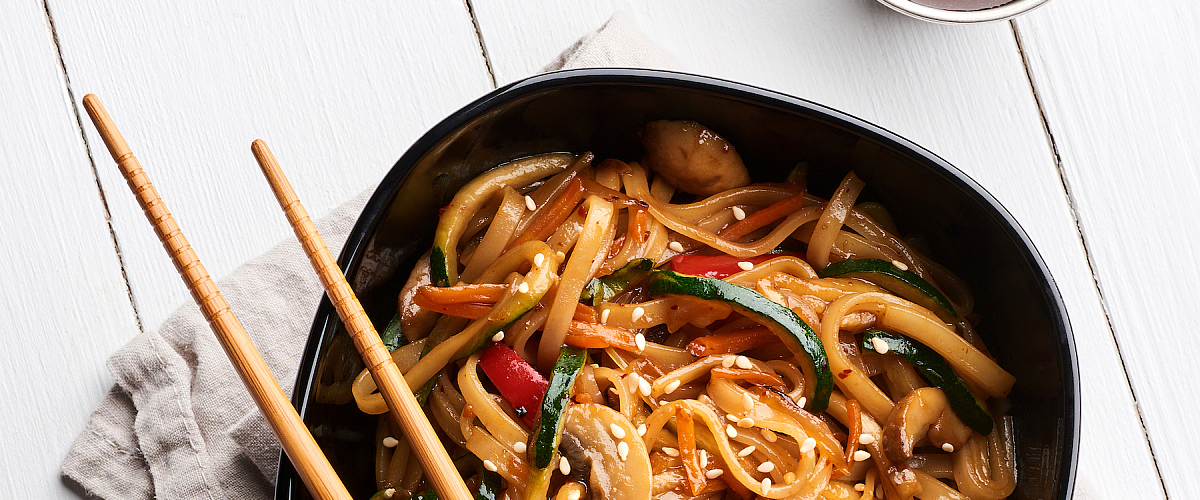We know food can be delicious and good for our bodies. But did you know that food can also be good for the planet?
Greenhouse gas (GHG) emissions contribute to climate change, a topic on nearly everyone’s mind these days.
While the burning of fossil fuels such as coal, oil, and natural gas make up a large portion of emissions, it may surprise you that more than one-quarter of the world’s GHG emissions come from food production—how it is grown, transported, processed, prepared, and discarded—according to the World Resources Institute (WRI).

Our experts: Kate Hanley and Kevin Kebea
And those GHG emissions from food can add up, especially for large foodservice companies like Aramark.
“Reducing carbon emissions is a high priority for us,” says Kate Hanley, Director of Global Climate Strategy with Aramark. “We estimate that over half of our carbon footprint comes from the food we purchase and serve from farm to fork. That’s why we have embarked as a company on several initiatives to reduce our carbon footprint and hit our targets for GHG emissions.”
One such initiative involves working with WRI to identify and label meals that are better for the environment while still being nutritious and tasty.
These Coolfood meals are available to diners at a growing number of university, business, and healthcare accounts in early 2023—and there are plans to expand the program in the future.
Read on to learn the principles behind Coolfood meals, find recipes to make at home, and learn additional tips to integrate climate considerations into your diet.
What Is a Coolfood Meal?
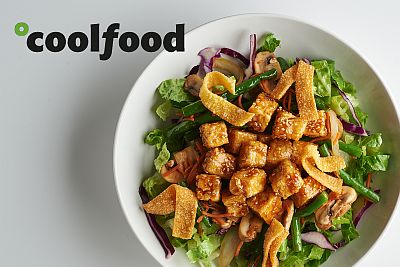 To become a certified Coolfood meal, WRI analyzes recipe ingredients to calculate a dish’s carbon footprint, including GHG emissions and the amount of land used to produce that meal.
To become a certified Coolfood meal, WRI analyzes recipe ingredients to calculate a dish’s carbon footprint, including GHG emissions and the amount of land used to produce that meal.
In general, dishes that contain beef, lamb, and dairy have a higher carbon footprint than vegetables, legumes, and grains.
But that doesn’t mean Coolfood dishes have to be vegetarian or vegan.
Eating more plant-forward—making vegetables, legumes, and whole grains the stars of the plate while using a small amount of meat—can be better for the environment and can often be better for you, too.
“All recipe ingredients fall on a scale of carbon contributions that get calculated before they become a Coolfood meal,” explains Kevin Kebea, Culinary and Menu Enablement Director at Aramark. “Simply changing from beef to chicken in a dish may do it, but, if there is a lot of cheese and other dairy products, the recipe might not meet the criteria to be certified as a Coolfood meal.”
That’s because of both the dairy ingredient’s carbon footprint and nutritional profile.
Similar to the recipes you find here on Feed Your Potential 365, WRI assesses a dish’s calories, saturated fat, sugar, sodium, fiber, protein, and fruit/vegetable levels to meet Coolfood meal standards.
If you’re worried about getting enough protein without meat, remember that protein can be found in beans, legumes, brown rice and other whole grains, soy, nuts, fish, eggs, and some vegetables, which all have a lower carbon footprint, according to WRI.
Try It at Home
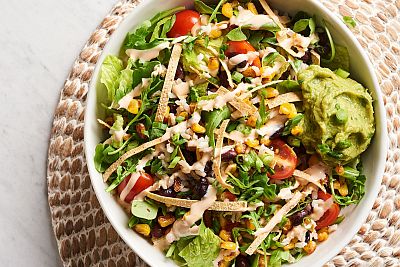
Get Recipe: California Taco Salad
Making delicious, healthy, climate-friendly food at home has never been easier! Easy-to-follow versions of the following Coolfood recipes are available on our website:
- California Taco Salad
- Spicy Shrimp and Penne
- Butternut and Black Bean Chili with Quinoa
- Eggplant Meatballs Marinara
- Chicken & Cauliflower Salad Wrap
- Portobello Mushroom and Corn Tacos
- Ginger Soy Salmon Bowl
- Roasted Butternut Tartine
More Ways to Be Climate-Friendly
While eating plant-forward is one good way to take positive steps for the environment, it certainly isn’t the only way.
“Choosing Coolfood meals is just one part of a solution,” says Kevin. “There are lots of other ways you can be aware about your food choices and your personal carbon footprint.”
Here are four things to try at home.
1. Variety is the spice of life.
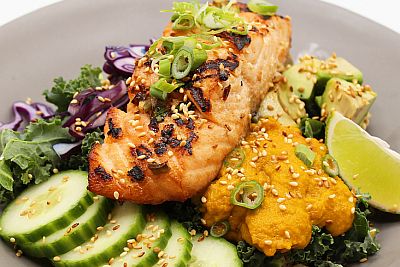
Get Recipe: Ginger Soy Salmon Bowl
According to experts, 75% of the world’s food supply comes from just 12 plants and five animal species! That lack of agrobiodiversity is bad for the environment due primarily to expanded agricultural production.
Bonus: Eating more variety can be healthier, too!
If you broaden the fruits, vegetables, and grains you eat, your body gets a whole range of nutrients.
Plus, switching things up in your meals and snacks helps you avoid getting stuck in that same-old meal routine.
2. Reduce, reuse.
A lot of food packaging, utensils, wraps, and other items are made from what are called single use plastics (SUPs) that can’t be recycled.
Plastics are primarily made from fossil fuels, resulting in carbon-intensive activity throughout the material’s life cycle from the fossil fuel extraction and manufacturing of single-use products to waste management when these products end up as litter in the environment.
By focusing on actions that reduce and reuse, there are a lot of opportunities to avoid creating waste in the first place.
For example, refuse plastic cutlery on your favorite mobile ordering platform and instead bring your own.
Carry a reusable bag to go shopping. A single plastic grocery bag can take 1,000 years to degrade and even then, it never fully decomposes and instead becomes tiny problematic microplastics!
Do you have reusable containers when eating on-the-go?
At home, choose to buy products without packaging or with recyclable packaging. And whether you’re at home, work, or on the road, choose to reuse by bringing your own bottle or cup.
3. Waste not.
Did you know that about 35% of all food in the U.S. goes unsold or uneaten—and thrown away?
In addition to the losses in human labor, energy, water, and transportation costs, food loss and waste causes GHG emissions. It is estimated that wasted food accounts for about 4% of our GHG emissions in the US.
At Aramark, we’ve committed to reducing food waste by 50% by 2030. But what can you do to reduce food waste at home?
One tip is to go shopping with a list—and stick to it! Figure out what items and how much you need in the coming days (or week) so food doesn’t have a chance to spoil. Buy smaller quantities of fresh food and choose canned, frozen, or more shelf-stable foods that will last longer.
Another idea? Brush up on the proper ways to store food. Do your fruits and veggies belong in the fridge, in the pantry, or on your countertop? Here’s a guide on storing food from the American Heart Association.
Get more ideas for tackling food waste at home on our blog. Or check out this article from the EPA.
4. Get scrappy!
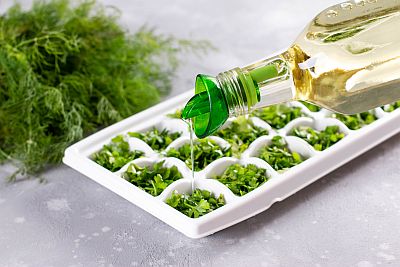 There are even more ways you can cut down on food waste at home. With a little culinary creativity, you can turn food you may otherwise throw out into healthy and delicious meals.
There are even more ways you can cut down on food waste at home. With a little culinary creativity, you can turn food you may otherwise throw out into healthy and delicious meals.
For example, turn scraps like onion skins, carrot peels, celery tops, and mushroom stems into a stock for soup. If you aren’t ready to make soup, freeze them for use later.
Bread that’s gone a little stale? Toast it for tasty homemade croutons or breadcrumbs.
Grate orange and lemon peels for sauces, desserts, fish, and poultry dishes. Or infuse olive oil with citrus peels to make a marinade or salad dressing. Just take as much of the bitter white part off as you can.
Do the same with herbs stems you’d normally discard: add them to olive oil. Too many herbs to use fresh? Wash and chop them, add water or oil, and freeze for later use.
Find even more ways to get scrappy and reduce waste on our blog.
Working Together
Bottom line, there are steps we can all take to reduce our carbon footprint. Aramark is focused on the links between climate and food, and we invite you to join us in thinking and moving in a direction that benefits the planet.
“All of us—consumers, companies, governments, and nonprofits—are part of a movement to tackle important issues like climate change,” says Kate. “If we make climate-friendly food choices a habit, we can make a positive difference.”
Learn more about Aramark’s commitments to environmental sustainability, reducing GHG emissions, and taking the Coolfood Pledge.
Note: Since everyone’s health history and nutritional needs are so different, please make sure that you talk with your doctor and a registered dietitian to get advice about the diet and exercise plan that‘s right for you.

